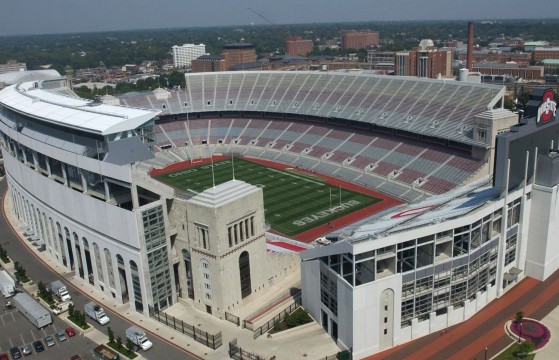
The Buckeye Country Superfest is set to take place June 20 and 21, 2015, at Ohio Stadium.
Credit: Courtesy of OSU.
Ohio Stadium is set to host a two-day country music show next summer, the stadium’s first concert in more than a decade, and vice president and athletic director Gene Smith said he hopes it isn’t a one-off affair — though a lot of scheduling, planning and problem-solving will go into it.
Though Ohio Stadium hosted a number of major concerts in the 1990s, its latest came in 2003, and featured Metallica, Limp Bizkit and Linkin Park.
The decline of big shows like these was something Smith said permeated the United States.
“It was so hard to get a critical number (of attendees) to make a profit,” Smith said. “For a while, they really didn’t do a lot of stadium shows, particularly in the Midwest.”
Xen Riggs, an associate vice president for Student Life, has handled much of the booking for 2015’s Buckeye Country Superfest, which is promised to bring in “the biggest stars in country music,” according to the event’s website. The country show is estimated to bring in $30 million, and the university hopes it will become an annual event. Riggs said there are additional shows also in the works.
Riggs said a concert of this magnitude had been in long-term development after Smith gave clear “marching orders” to make the stadium more active.
Producing a show at a stadium like this comes with a number of challenges though, and Riggs said they tend to be 10 times more expensive than shows at a venue like the Schottenstein Center.
Because of the costs, he said the biggest challenge in making it happen was the ability to secure a big enough name. Continuing renovations over the last few years were also a challenge to work with, but their completion, especially the new permanent lights, now makes hosting a show easier.
The switch from grass to turf, which took place in 2007, also facilitates the concert. The number of people on the field can still cause challenges.
“It’s permanent surface, but it has an extremely sophisticated drainage system, and pressure can be a threat (to that system),” Riggs said.
Infrastructure costs are a major obstacle to making a stadium show work as well, Riggs said. Unlike a show at Schottenstein Center, a show at Ohio Stadium will require five to six days of construction and demolition after each show.
Riggs also said attempting a show at Ohio Stadium can be “hit or miss.” While contemporary stadium shows tend to be in larger markets, Riggs said Ohio Stadium is “one of the iconic structures of its century” and the football team gives it popular appeal, which can drive attendance from all over.
Its large capacity, now at 104,944, is still a difficulty however.
“Ohio Stadium is just so stinking big,” Riggs said. “Trying to fill up Ohio Stadium is a challenge.”
Few acts have enough power to draw in a big enough audience to make the show profitable, he said. While the full lineup for next summer’s show isn’t set to be announced until Tuesday, Riggs said the community can expect star power comparable to the Bayou Country Superfest, which brought in Taylor Swift, Kenny Chesney, Keith Urban and others for its first show.
That event, held each year since 2010 at Louisiana State University’s Tiger Stadium, is produced by Festival Productions Inc. — New Orleans, the same company that will produce Buckeye Country Superfest and has also organized celebrations for presidential inaugurations and the New Orleans Jazz & Heritage Festival.
Smith said he has been trying to bring a concert to Ohio Stadium since he came here in 2005, and is glad Riggs has finally made it possible.
And for Riggs, making it possible means making sure all the details are worked out. In a stadium show, everything simply has to be bigger and better.
“You can’t put up a 40 x 60 foot stage and have it look anything but like a postage stamp,” he said.
Other infrastructure like delay towers — which coordinate speaker output to account for the speed of sound — and spotlight towers, will also need to be built.
That construction and accommodation for performers will require more catering, security, police and dressing rooms — all things that drive up cost.
The athletic department will get a profit from renting out the stadium, but Smith said that money is negligible compared to what the concert will do for the community.
“When you have that many people, they end up buying things in the community — going to our restaurants, staying in hotels overnight and buying gas. They’ll spend their dollars here,” he said.
Excluding ticket sales, the $30 million expected to flow into the Columbus area is similar to the economic impact of the Bayou Country Superfest.
If concerts like Buckeye Country Superfest become a long-term trend, Smith said it shouldn’t do anything to hinder the football team’s use of the facility.
“Everyone is well aware of the football dates, and we’re constantly communicating with what issues we might have,” Smith said. However, he added that expanding the stadium’s role is “a priority for our institution, so we might have to sacrifice a date here and there, but it’s not like we’ll schedule one of these on a football Saturday.”


